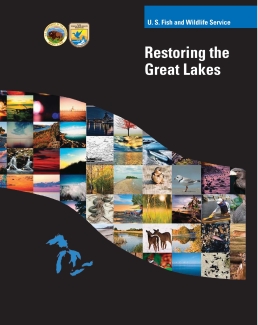
The Great Lakes Restoration Initiative marks the country’s renewed interest in the protection and restoration of the Great Lakes. Comprised of more than 10,000 miles of coastline and 30,000 islands, the Great Lakes provide drinking water, transportation, power, jobs and recreational opportunities to the 30 million citizens who call the Great Lakes basin “home.” Holding 95 percent of the United States’ surface fresh water, the Great Lakes are too valuable a resource to lose to such threats as toxic substances or invasive species invasive species
An invasive species is any plant or animal that has spread or been introduced into a new area where they are, or could, cause harm to the environment, economy, or human, animal, or plant health. Their unwelcome presence can destroy ecosystems and cost millions of dollars.
Learn more about invasive species . Nestled between the U.S. and Canada, and spanning across eight U.S. states and many tribal lands, the management of the Great Lakes represents both an international and interstate challenge that necessitates the highest levels of coordination.
Grounded in collaboration, the Great Lakes Restoration Initiative was first envisioned in 2005 by more than 1,500 stakeholders from diverse backgrounds who contributed to the creation of the Great Lakes Regional Collaboration Strategy. In 2009 President Obama’s fiscal year 2010 budget put aside $475 million for the Great Lakes Restoration Initiative to target the most significant environmental problems impacting the Great Lakes’ ecosystem. Through an inter-agency agreement with the U.S. Environmental Protection Agency, the U.S. Fish and Wildlife Service became a federal partner in the implementation of GLRI. Captured on the pages of this booklet is a sampling of what the Service accomplished in the first year of the Initiative. From fighting the spread of Asian carp, to creating an early warning system for new chemical pollutants, to wetlands restoration, the Service worked to efficiently and effectively transform more than $65 million dollars into on-the-ground environmental improvements.
Many citizens have experienced the wonders of the Great Lakes—be it catching a glimpse of piping plovers darting across the sand or spying the shadowy forms of lake sturgeon beneath the water’s surface. For those who do not have everyday access to the Great Lakes, on your next trip to the region we invite you out to our national wildlife refuges and national fish hatcheries to view for yourself not only the fish and wildlife of the Great Lakes, but also the people who depend on this resource as a source of income and way of life. With the help of the Great Lakes Restoration Initiative the Service and our project partners are working to insure that the Great Lakes remain “great” for you and future generations.
| Attachment | Size |
|---|---|
| GLRI-Restoring-Great-Lakes-2010.pdf3.41 MB | 3.41 MB |